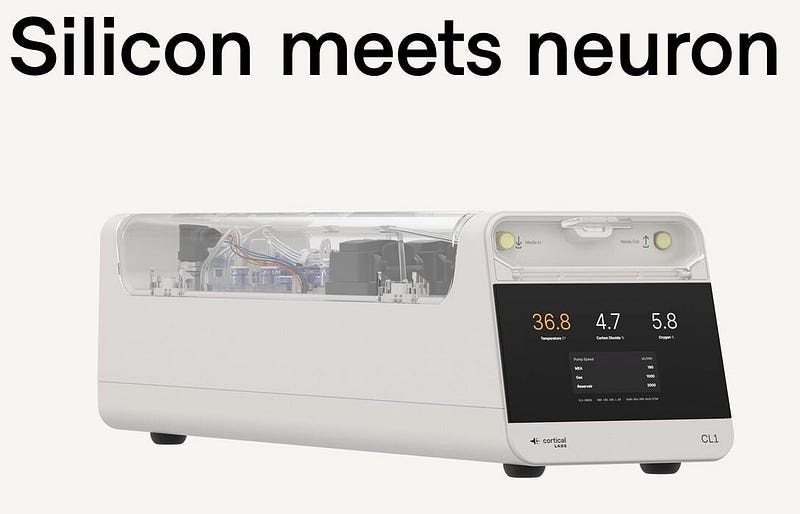I used to think artificial intelligence was just about silicon chips and code. Then I discovered something that completely shattered that assumption: A laboratory dish containing living human brain cells that learned to play Pong in just minutes (along the lines of ~5–20 minutes).
While tech giants pour billions into faster processors and more sophisticated algorithms, a small group of scientists has been quietly growing actual intelligence.
Not simulating it. Not programming it. Growing it.
And what they’ve discovered will fundamentally change how we think about the future of computing.

The Dish That Changed Everything
In 2022, researchers at Cortical Labs achieved something that sounds like science fiction. They successfully grew human neurons in a laboratory dish, placed them on a grid of thousands of tiny electrodes, and connected this biological system to a simplified version of Pong.
The results were staggering.
These lab-grown neurons didn’t just learn to play the game but mastered it in mere minutes (and yes, they didn’t reach the deterministic expert level seen in trained AIs). Human brain cells were controlling the paddle, tracking the ball, and showing adaptive behaviour. The neurons received sensory input about the ball’s position through electrical stimulation and responded by firing collectively to move the paddle up or down.
But here’s where it gets really interesting: when researchers tested with non-neural cells (HEK293T kidney cells) as a control group, these cells did not learn to play Pong. But, they performed at media control (i.e., baseline) levels and showed no evidence of learning or improved performance over time. So, specialized neural architecture (brain cells) outperformed other tissues: kidney cells and non-neural controls did not learn or adapt as neurons did.
Why Your Laptop Can’t Compete
The energy efficiency alone should make Silicon Valley executives lose sleep. These biological computers could plausibly achieve the same learning outcomes as traditional silicon-based systems with less energy (because biological brains are orders of magnitude more energy efficient than artificial neural networks)
Think about that for a moment. While companies like Google and OpenAI are building massive data centres that consume the power equivalent of small cities, a petri dish of neurons can now run a basic closed-loop system with a pre-set reward signal structure. This is much simpler than tasks handled by commercial AI or data centres, but it is a first step into an interesting direction.
The learning mechanism is elegantly simple yet profoundly sophisticated. When the neurons successfully hit the ball, they receive predictable, gentle electrical stimulation across all electrodes, essentially a biological reward signal. Miss the ball, and they get four seconds of chaotic, unpredictable stimulation that acts as negative feedback.
Within this reward-punishment cycle, something remarkable happens: The neurons begin reorganizing themselves. They increase coordinated firing patterns between sensory (input) and motor (output) electrode regions. Functional connectivity (but not direct synaptic mapping) increased as the neural cultures learned to play Pong. The system becomes more coordinated and goal-directed. It’s optimization happening at the cellular level, in real time.
The Cyberpunk Reality We’re Already Living
What caught my attention wasn’t just the scientific breakthrough but it was discovering that Cortical Labs is already commercializing this technology. You can visit their website right now and purchase biological computers powered by living neurons.
We’re not talking about some distant future possibility. This is happening today.
The implications extend far beyond gaming demonstrations. These hybrid biological-digital systems could revolutionize drug testing, offering researchers the ability to study how compounds affect neural computation in real time. Brain-computer interfaces could become fully integrated biological systems rather than clunky external devices.
Consider the possibilities: If you study neurological diseases using actual living neural networks, developing treatments that work with biological intelligence rather than against it, or creating computing systems that adapt and evolve like living organisms.
What This Means for the AI Arms Race
While major tech companies compete to build larger language models and faster processors, biological computing represents a completely different approach to intelligence. Instead of simulating consciousness, we’re working with actual conscious material.
This raises deep questions about the nature of intelligence itself. When human neurons outperform mouse neurons in these experiments, we’re seeing evidence that different types of biological intelligence have distinct computational capabilities. The structural differences between species translate into measurable performance differences in artificial environments.
But it also forces us to confront uncomfortable questions about consciousness and ethics. If we’re using actual neural tissue to perform computational tasks, what are our responsibilities toward these biological systems? When does a collection of neurons become something more than just organic hardware?
A Gentle Earthquake of AI Innovation
The most fascinating aspect of this story is how quietly it’s unfolding. While mainstream media focuses on ChatGPT and Silicon Valley’s latest AI announcements, researchers are literally growing intelligence in laboratories around the world.
This isn’t just another incremental improvement in processing power. It’s a fundamental shift from artificial intelligence to biological intelligence operating in digital environments. We’re witnessing the emergence of true hybrid systems that blur the line between living organisms and computing machines.
Companies like Cortical Labs aren’t just building better computers. No, they’re pioneering an entirely new form of technology that could make traditional silicon-based systems look as outdated as vacuum tubes soon.
What Happens Next?
The trajectory is clear here. Biological computing will likely become mainstream within the next decade. The energy efficiency alone makes it economically inevitable, especially as traditional computing approaches physical limits.
But the real question isn’t whether this technology will succeed but whether we’re prepared for a world where the line between artificial and biological intelligence first blurs and then disappears entirely.
As I write this, somewhere in a laboratory, neurons grown from human stem cells are learning, adapting, and solving problems. They’re not following pre-programmed instructions or executing algorithms. They’re demonstrating adaptive, reward-driven pattern changes. Just some steps away from thinking.
The age of silicon intelligence is ending before it really began. The age of biological computing has already started.
The only question that remains is how you will be part of this revolution, or if you will be disrupted by it?
Further Reading
In vitro neurons learn and exhibit sentience when embodied in a simulated game-world. Kagan, Brett J. et al. Neuron, Volume 110, Issue 23, 3952–3969.e8













Share this post